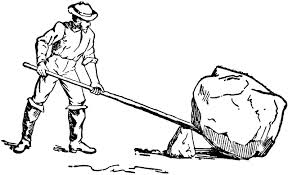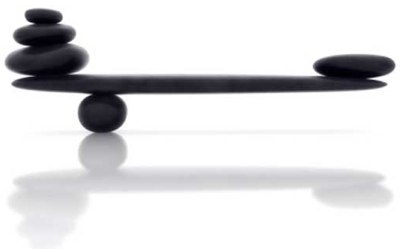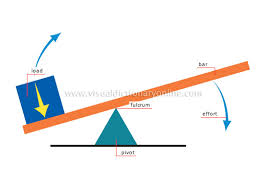
Yellow Belt
- Understanding Leverage, Force, and Change
- Basic Positions
- Basic Submissions
- Yellow Belt Trip sets
- Body Movement and break falls
- Kata Chanan 2
- Yellow belt Boxing sets
- Yellow belt chamber sets
- Yellow belt conditioning
Understanding Leverage
The Elements of Leverage
- Fulcrum:The support on which a lever turns

- Load:A mass of weight supported by something

- Effort:Applied force

- Lever:The lever is a movable bar that pivots on a fulcrum attached to a fixed point.

3 Classes of Levers
Levers are classified by the relative positions of the fulcrum and the input and output forces. It is common to call the input force the effort and the output force The load or the resistance. This allows the identification of three classes of levers by the relative locations of the fulcrum, the resistance and the effort:
Class 1:Fulcrum in the middle: The effort is applied on one side of the fulcrum and the resistance on the other side, for example, a crowbar or scissor
Class 2: Resistances in the middle: the effort is applied on one side of the resistance and the fulcrum is located on the other side, for example, a wheel barrow or bottle opener. Mechanical advantage is greater than 1.
Class 3:Effort in the middle: the resistance is on one side of the effort and the fulcrum is located on the other side, for example, a pair of tweezers or human mandible. Machenical advantage is less than 1.
These classes are described by mnemonic "fre 123" where the fulcrum is in the middle for the 1st class lever, the resistance in the middle for 2nd class lever, and the effort is in the middle for 3rd class lever. The ideal lever does not dissipate or store energy, which means there is no friction in the hinge or bending in the beam. In this case, the power into the lever equals the power out, and the ratio output to input force is given by the ratio of the distances from the fulcrum to the points of application of these forces. This is known as the law of the lever.
Law of the lever
The lever is a movable bar that pivots on a fulcrum attached to a fixed point. The lever operates by applying forces at different distances from the fulcrum or a pivot. Assuming the lever does not dissipate or store energy, the power into the lever must equal the power out of the lever. As the lever rotates around the fulcrum points farther from this pivot move faster than points closer to pivot. Therefore a force applied to a point father from the pivot must be less than the force located at a point closer in, because power is the product of force and velocity. If a and b are distances from the fulcrum to points A and B and let FA applied to A is the input and the force FB applied at B is the output, the ratio of the velocities of points A and B is given by a/b, so we have the ratio of the output force, or mechanical advantage, is given by.
Force and Change
Forces are pushes or pulls on an object.
Forces have tow qualities:
- an amount (or magnitude)
- a Direction
Forces in the same line
A strong push to the right pushes some slowpoke out of your way. His push back at you cancels out your push towards him. You pull forward on the reins of a horse that you are leading, the horse pulls backwards on you. His pull being more than yours you move towards him not away. In the first case, think of these not as 2x amount of force summed from X amount in both directions but think instead of one forces as +1x in one direction and -1x force in the other. The directions were opposite so they have opposite signs but since the magnitudes are equal 1, the sum of +1 and -1 equals zero. Nobody moves. The second case has directions opposite and magnitudes unequal (+1x and -2y, the + and - indicating direction and the 1 and 2 as force magnitudes); the sum is -1y.
The point here is that you can't just equate the values or magnitudes of the forces.
1+1 does not always equal 2
You need to account for the direction of the force in this case, positive and negative (forward versus back, up versus down, inwards versus outwards, etc)
Forces along perpendicular lines still equal one total force
you need to know about their directions, only forces in the same line affect each other (Add together in both positive and negative ways)> A force that is perpendicular to another force doesn't affect the other force's effect. Some guy pulls you forward and another one pulls to the right, you will move in both directions. But ultimately, if you add all the "left-right forces" into one sum total force in this direction, and do the dame with the "up-down forces" into a second total force in this direction, you can finally add these up and get some single equivalent sum force (Magnitude) in one single equivalent directions. take a classroom of kids into a circle around you, give each one a rope to you and have them pull. in general, their forces will cancel out but if you do move, you will move in one direction, just as if the one kid in that position did all the pulling. You and slowpoke don't move because there is no total non zero force on you two. The total non zero force is call the net force and it has a single magnitude value and a single direction. Finally, it is not a given that you end up with a force of magnitude x and direction whatever. If the forces are opposite in direction but equal in amount, the net force is zero. There are still individual forces on you, they just happen to cancel out in sum because of the directional aspects. This is called equilibrium.
Forces means motions change
A change in motion is an acceleration, a change in velocities. A change in velocities equals a speed up or slow down but it is not a steady state.
Forces change motion in two ways
we have only talked about forces in one direction, forward-back. Recall that forces have directions as well as magnitudes. So what happens if the motion is in one direction at some speed, but the force is applied from the side? Then the direction of motion will change for sure. Sometimes the velocity amount does too, but it doesn't have to.
Circular motion
When an object moves in a circular path, there is an acceleration which is toward the center of the circle. This is called centripetal acceleration.
A centripetal force causes circular motion. When a centripetal force is applied to a moving object, its path curves. Without the force, the object would fly off in straight line (from Newton's First Law of Motion) as a result of inertia. When an object moves along a circular path at a constant speed, acceleration happens without a change in speed. the acceleration changes the direction of the motion.
Level Changes
Level changes can occur on diagonal, circular, and spiral planes.
Basic Positions
- Rear mounted position:Choke Guard
rear mount top:
- Escape the hooks to turtle and shoulder roll opponent.
- Escape the hooks to turtle roll to bottom rear mount and escape the back and roll into guard
Rear Mount bottom:
- Escape the back and roll into guard
- Hip Slide out escape (over under grip) follow the hand and bridge then roll in
- Shrug defense (Over under grip) shrug the hold and slip the arm
- Body lock escape (body triangle) use the elbow to escape the lock and walk out
- Double under hook escape step over, roll into side
- Laying rear mount escape (follow the hand bridge and walk out) variation
- Laying rear mount escape (shoulder choke block and redirect the choke)
- mount position: Elbow brace, knee shield
- Elbow slip into guard (elbow brace or hip press) The basic mount escape
- Choke brace and roll (opponent choke or punch) using choke guard and bridge
- Leg trap mount escape to back or kick out (reverse snake)
- Seated mount escape (opponent goes to seated mount to stop the escape) choke brace and knee press.
- Back door escape (bridge into roll out) set feet under opponents arm pits and kick through
- High mount break escape into guard (elbow brace and knee shield) dig into elbow
- Knee on belly positionL Straight leg block
- Rolling out into guard
- Turn in to leg tackle
- Side control position: Blocking and passing
- Elbow brace to leg sweep (opponent arm under neck)
- Push and pull throw over (opponent arm over neck) bridging throw
- Roll into guard (opponent arm under neck)
- Roll into leg tackle (opponent arm over neck)
- Roll out to guard (opponent arm under neck)
- Roll into/out to hip escape (Scarf holds/reverse scarf hold - roll into guard (kesa gate)




